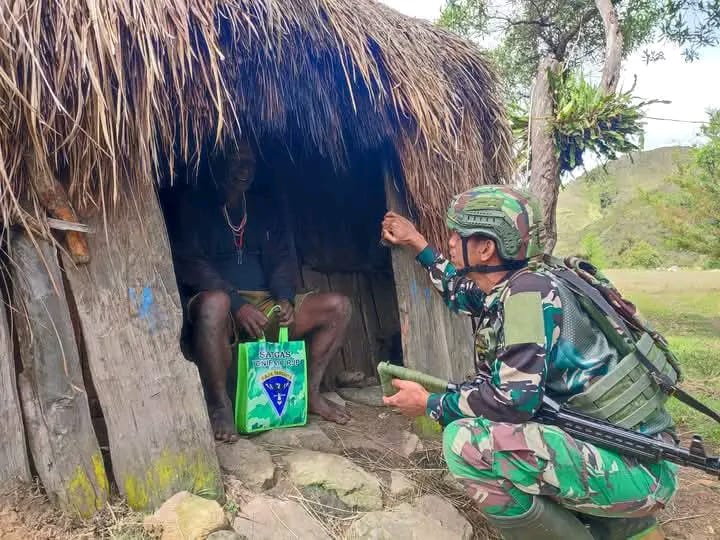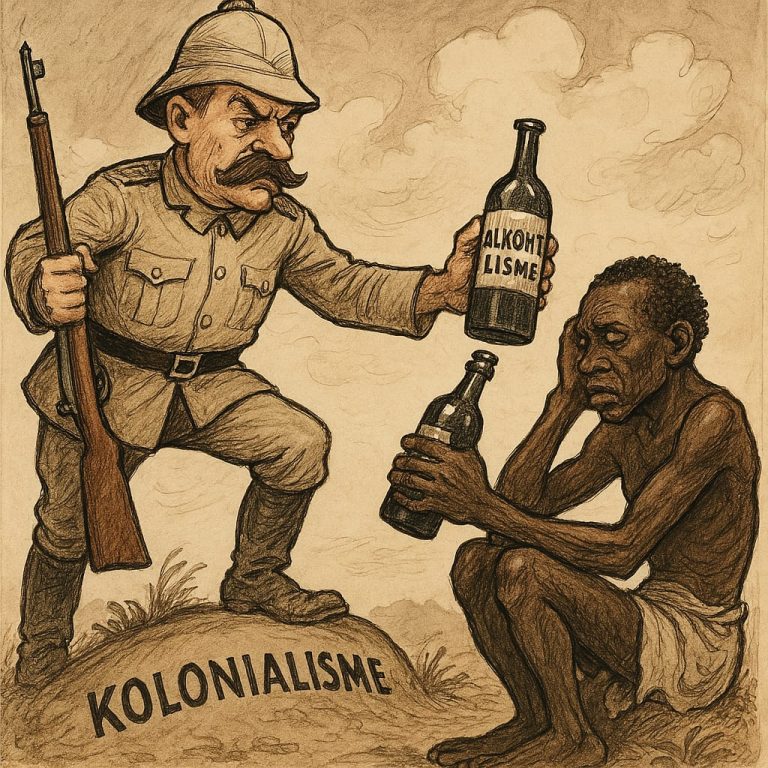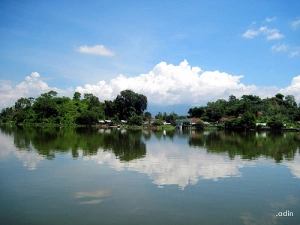
TNI personnel conducting a sweep operation in villages in Papua (photo courtesy).
In recent years, Central Papua, especially the Intan Jaya region, has been plagued by bloody conflict between the Indonesian National Army (TNI), the National Police of Indonesia (Polri), and the West Papua National Liberation Army (TPNPB).
This endless conflict not only involves an ideological battle between the Unitary State of the Republic of Indonesia (NKRI) and the desire for Papua’s independence but also revolves around the struggle to control the region’s valuable mineral reserves, particularly in the Wabu Block. The Wabu Block is believed to hold more than 8 million ounces of gold, making it a highly coveted area for both domestic and international interests.
In March 2025, tensions in Intan Jaya escalated once again. A series of attacks from TPNPB on military posts from TNI and Polri grew more intense, resulting in casualties on both sides. These attacks forced local residents to flee into the forests or to other regions to escape the violence.
One of the most significant incidents was the death of a TNI soldier from the 305/Tengkorak Infantry Battalion, Corporal Fuad Nawazir Siregar, who was killed in a TPNPB attack on March 28, 2025, in Intan Jaya. In a press release issued by Sebby Sambom, the spokesperson for the TPNPB Headquarters, the attack was carried out by a TPNPB sniper during a battle that lasted from the afternoon into the evening.
As a result of the attack, three TNI personnel were reported to have been shot, including Corporal Siregar, who later succumbed to his injuries. In the statement, Sebby also mentioned that TPNPB personnel from the VIII Intan Jaya Defense Command had been deployed to confront the TNI-Polri forces in Zanamba.
This attack was reportedly in response to the deployment of TNI troops moving toward the Hitadipa District, which was detected by TPNPB intelligence personnel in Mamba. Further reports indicated that TPNPB’s VIII Intan Jaya command had announced plans to expand military operations to Sugapa.
“We are responsible for this attack, so Indonesian soldiers and police can come after us, but not the local civilians,” Sebby emphasized in a video released by the TPNPB’s Central Command the day after the attack. This assault appeared to be a retaliatory measure for previous ground and air assaults carried out by TNI-Polri forces.
This included the shooting of four TPNPB members on Sunday, January 21, 2024, in Intan Jaya. The four TPNPB members who died from TNI gunfire included Oni Kobagau, Jaringan Belau, Agustia, and One.
“From the drone footage, one member of the KKB (TPNPB), named Melkias Maisani, was also killed in that attack. His body, along with the firearm he used, was taken away by his comrades,” said AKBP Bayu Seseno, the spokesperson for the Damai Cartenz Operation, in a press release.
The cycle of retaliatory attacks between both sides continued as part of a long-standing conflict. In March 2025, the escalation of sporadic attacks carried out by TPNPB intensified, with more military posts and other military facilities in Intan Jaya becoming targets.
General Agus Subiyanto, Commander of the TNI, explained that the military would continue using a territorial approach in their operations. The TNI continued to label the armed groups seeking Papua’s independence as the Free Papua Movement (OPM), as well as referring to TPNPB as Armed Criminal Groups (KKB).
The territorial operations mentioned by General Subiyanto aim to involve all parties in the development and welfare of the Papuan people. This approach is carried out through both ‘soft power’ and ‘hard power’ strategies.
“Soft power is through territorial operations. For example, by helping to accelerate development and improve welfare. Meanwhile, hard power operations involve confronting armed groups (TPNPB) with force because they are armed,” explained General Subiyanto.
Contesting the Wabu Block
The Wabu Block, located in Intan Jaya Regency, Central Papua, has become a focal point due to its vast natural wealth. Gold reserves in this area are estimated to exceed 8 million ounces, with a value that could reach hundreds of trillions of Indonesian Rupiah.
This makes it one of the largest mineral resources in Indonesia, second only to the reserves managed by PT Freeport in Timika. The discovery of these reserves has attracted the attention of various parties, including the Indonesian government, major mining companies, national entrepreneurs and oligarchs, senior TNI-Polri officials, and the separatist groups accused of seeking independence for Papua.
The Wabu Block is at the heart of this conflict, not only because of its strategic location but also due to the enormous potential of its natural resources. “If exploited wisely, this could be an incredible source of income for the country and the local community,” said Ariyanto Budiman, Director of PT Aneka Tambang Tbk (Antam), when asked about the potential of the Wabu Block.
However, the ambition to exploit these mineral reserves is likely to bring about social, political, and environmental consequences. Indigenous Papuans, particularly pro-independence groups, view the presence of mining companies as a threat to their ancestral rights.
Not only that, but the ambition to exploit Papua’s natural resources through the involvement of mining companies supported by the Indonesian military (TNI-Polri) is seen as a continuation of systematic colonialism over Papua’s rich land.
“The thieves and robbers have long been eyeing our wealth. We don’t want this to happen like it did with Freeport in Timika. Stop already. We want to live on our own and determine our own future,” said John Belau, a student activist from Intan Jaya who requested his real name not be published.
One of the major projects currently being pushed is PT Antam’s plan to manage the Wabu Block. Although some parties support the project, it is strongly opposed by many groups in Papua, who argue that mining exploitation in the Wabu Block will worsen social, economic, and political injustices and harm the dignity of indigenous people.
PT Freeport Indonesia, which previously managed the gold reserves in the Wabu Block, pulled out in 2015, leaving a gap that others now seek to exploit for management rights. One company showing interest is PT Aneka Tambang (Antam), which is in negotiations with the government to obtain exploitation permits for the area.
However, the Wabu Block is not just about gold reserves. The area is located in the heart of the indigenous Papuan land, which has long been seeking recognition of its land rights. Tensions have escalated with efforts to exploit natural resources without involving or considering the interests of the local communities, who often feel marginalized in decision-making processes.
Military Operations and Advanced Technology
In response to the ongoing series of attacks, the Indonesian National Army (TNI) and the Indonesian National Police (Polri) have intensified their operations in several areas of Papua that are considered security threats by the West Papua National Liberation Army (TPNPB), including in Intan Jaya, Central Papua.
As a response to the fierce resistance from TPNPB, the Indonesian military and police are now relying on advanced military technology to support their operations on the ground. In addition to deploying ground forces, Indonesia’s military has also incorporated drones to conduct surveillance and airstrikes.
According to recent data from TNI, drones with high reconnaissance capabilities are being used to provide real-time information on TPNPB movements. Additionally, combat aircraft, military helicopter, including Spanish-made CN-235 planes, are being used to carry out airstrikes on areas believed to be strongholds of the separatist TPNPB groups.
The use of drones and fighter jets signals an escalation in the military operations, with both air and ground attacks becoming increasingly intense. However, the use of such technology has also led to negative consequences, particularly for civilians caught in the midst of the conflict.
Airstrikes from fighter jets and drones often do not only target separatist group infrastructure but also damage civilian homes, exacerbating the humanitarian crisis by forcing more local residents to flee to safer areas.
“The civilian population is increasingly marginalized. They are caught in a conflict that shouldn’t involve them,” said Hening Saldi, a displaced resident who fled to Nabire. “We just want to live peacefully without war.”
Conflict and Future Solutions
The ongoing conflict in Intan Jaya, Central Papua, has caused thousands of civilians to flee their homes, seeking refuge in safer areas. Data from humanitarian organizations in Papua shows that more than 5,000 people have been displaced since the beginning of military operations in early 2024.
“Right now, we can’t return to our homes. We don’t know when it will all end. We just hope to live in safety,” said Timotius Yamo, a refugee from Intan Jaya. “We need help, food, and proper shelter.”
The situation in refugee camps is dire. Limited access to basic necessities such as food, clean water, and healthcare has made life increasingly difficult for the displaced population. Reports from the Papua Sejahtera Foundation (YPS) indicate that over 40% of the refugees suffer from skin diseases and respiratory infections due to inadequate living conditions.
The prolonged conflict in Intan Jaya demands a comprehensive and sustainable solution. According to researchers and human rights activists, to end the conflict in Papua, the Indonesian government must involve the Papuan people in decision-making processes, particularly in the management of the region’s natural resources.
Al Araf, the head of the Centra Initiative and senior researcher at Imparsial, emphasized that resolving the Papua issue should prioritize a dialogue-based process. He noted that the government has always approached the issue of Papua with a top-down, non-dialogical approach. “The resolution of the conflict should come from an agreement between the conflicting parties, namely the government and the Papuan side,” he said.
According to Al Araf, such a solution would likely follow a model similar to the peace process in Aceh. “The focus has largely been on economic aspects. Meanwhile, the issue of legal justice for past violence and human rights violations has often been ignored,” he added.
A fair and dialogue-based resolution is key to ending the prolonged conflict. Without an inclusive and humanistic approach, the Indonesian government will continue to face significant challenges in Papua.
However, the Papuan people and pro-independence activists have long held demands that they believe are essential for the future of Papua, its people, and its natural resources. They argue that the Papuan people need the right to determine their own fate and achieve independence. (Julian Haganah Howay)





